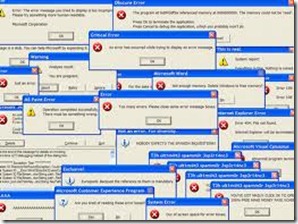ERRORS
An error is a condition which causes a computer to fail to produce the expected results.
Errors occur at all stages of developing and implementing a program and a large proportion of computing effort is aimed at detecting or avoiding them.
The main causes of errors are:
1 Faulty system design.
2 Hardware failure.
3 Errors in the program.
4 Errors in the data.
5 Inaccurate calculation.
Program Errors
An error in a program is called a bug. Bugs may be one or more of the following.
SYNTAX ERRORS
A syntax error occurs when a language is not used correctly. A compiler or interpreter will not be able to translate statements with syntax errors because they do not make sense.
Syntax errors usually occur because:
1 The programmer has misunderstood the rules of the language; or
2 A transcription error has been made. A transcription error is a mistake made in writing or keying.
Examples of syntax errors in BASIC
1 300 LET A=2(X+3)
This should read ‘300 LET A=2*(X+3)’. The programmer probably did not realize that an asterisk was needed.
2 100 IF A$="***" TEN 200
This should read ‘100 IF A$="***" THEN 200’. This was probably a transcription error.
LOGICAL ERRORS
A logical error occurs when the program designer or the programmer makes a mistake in working out the sequence of instructions required to produce a particular result.
Exam pies of logical errors
1 The following BASIC program module is intended to print ‘INCORRECT MONTH’ whenever the value of MONTH is not between 1 and 12, inclusive.
100 REM ******* MONTH CHECK *******
110 IF MONTH>12 THEN 200
120 IF MONTH<1 THEN 200
200 PRINT "INCORRECT MONTH"
In fact there is a logical error because it will still execute line 200 and print ‘INCORRECT MONTH’ if MONTH does lie between 1 and 12. A GOTO statement is required at tine 130, so that line 200 is not executed if the month is acceptable.
2 The following module is intended to input a set of names into the array SNAME$:
200 REM ***** INPUT SURNAMES *******
210 PRINT "TYPE EACH SURNAME. THEN PRESS ‘RETURN’" 220 PRINT "AFTER THE LAST NAME. ENTER ·
230 LET COUNT=0
240 LETCOUNT=COUNT+l
250 INPUT SNAME$(COUNT)
260 IF SNAME$(COUNT) = " *** " THEN 500
270 GOTO 230
When this module has been run SNAME$(1) will have the value "***". All the other elements of SNAME$ will be blank and no names will have been stored. This is because line 270 says ‘GOTO 230’, which sets COUNT=0 every time round the loop. Line 270 should read ‘GOTO 240’, so that COUNT is incremented.

